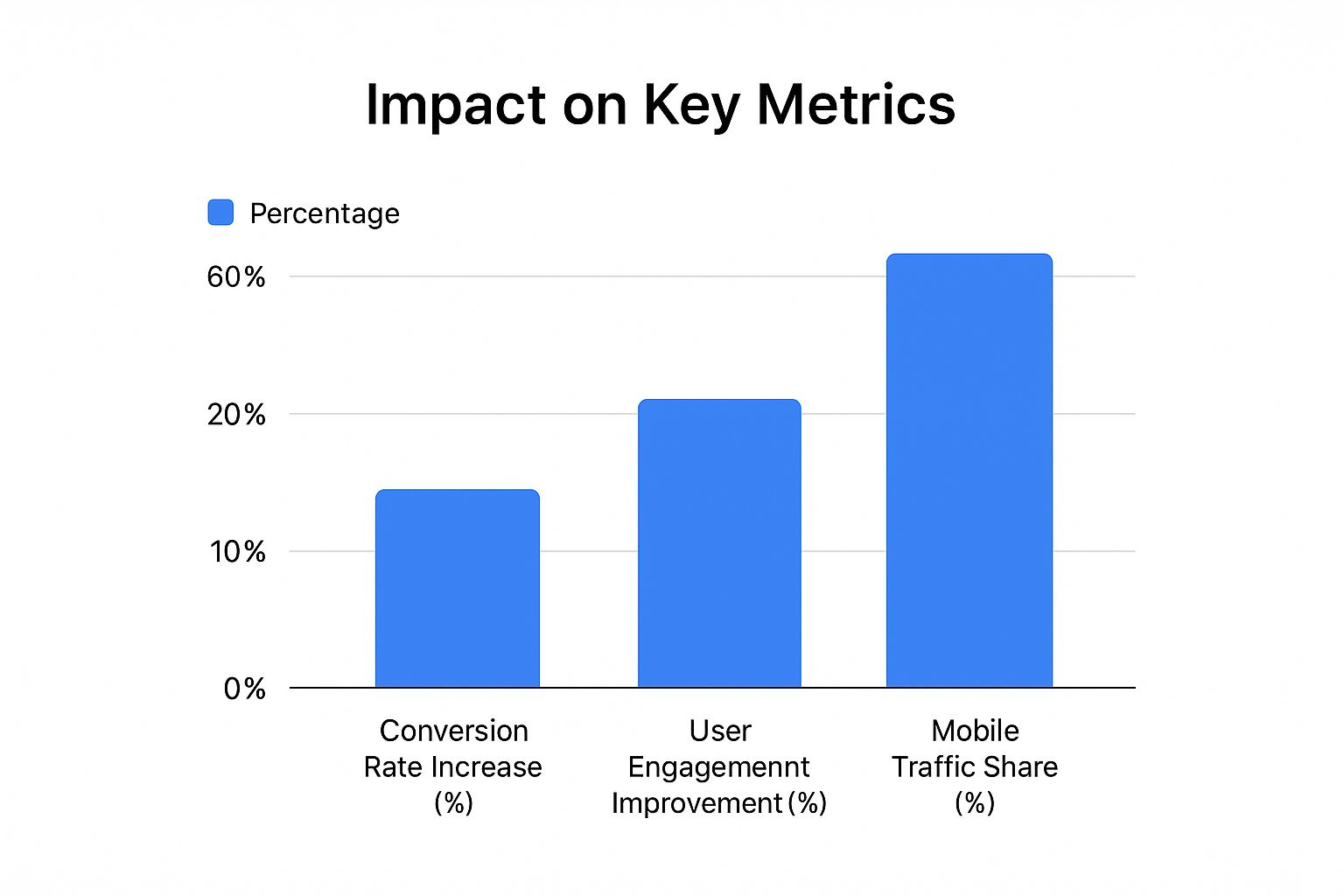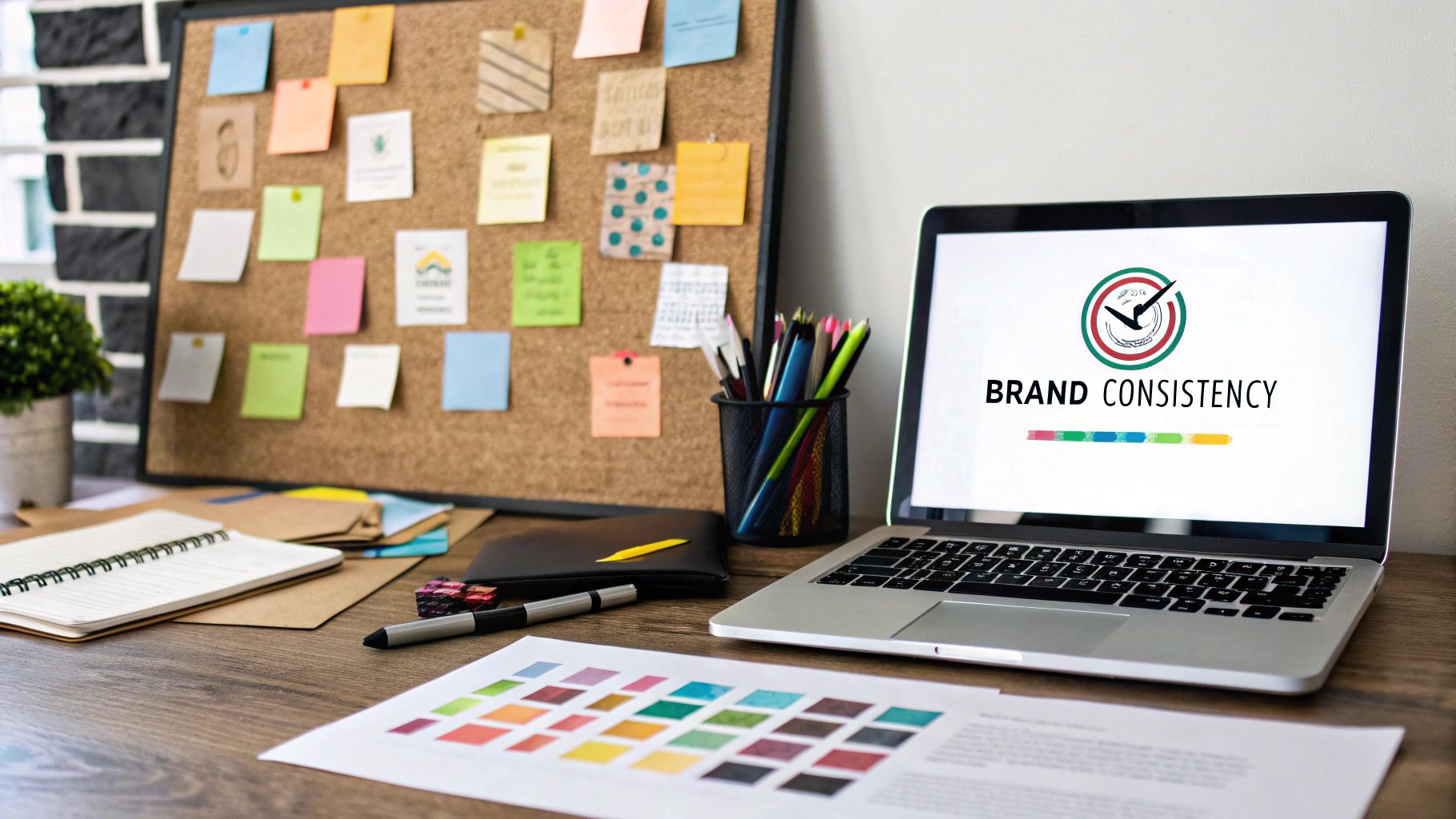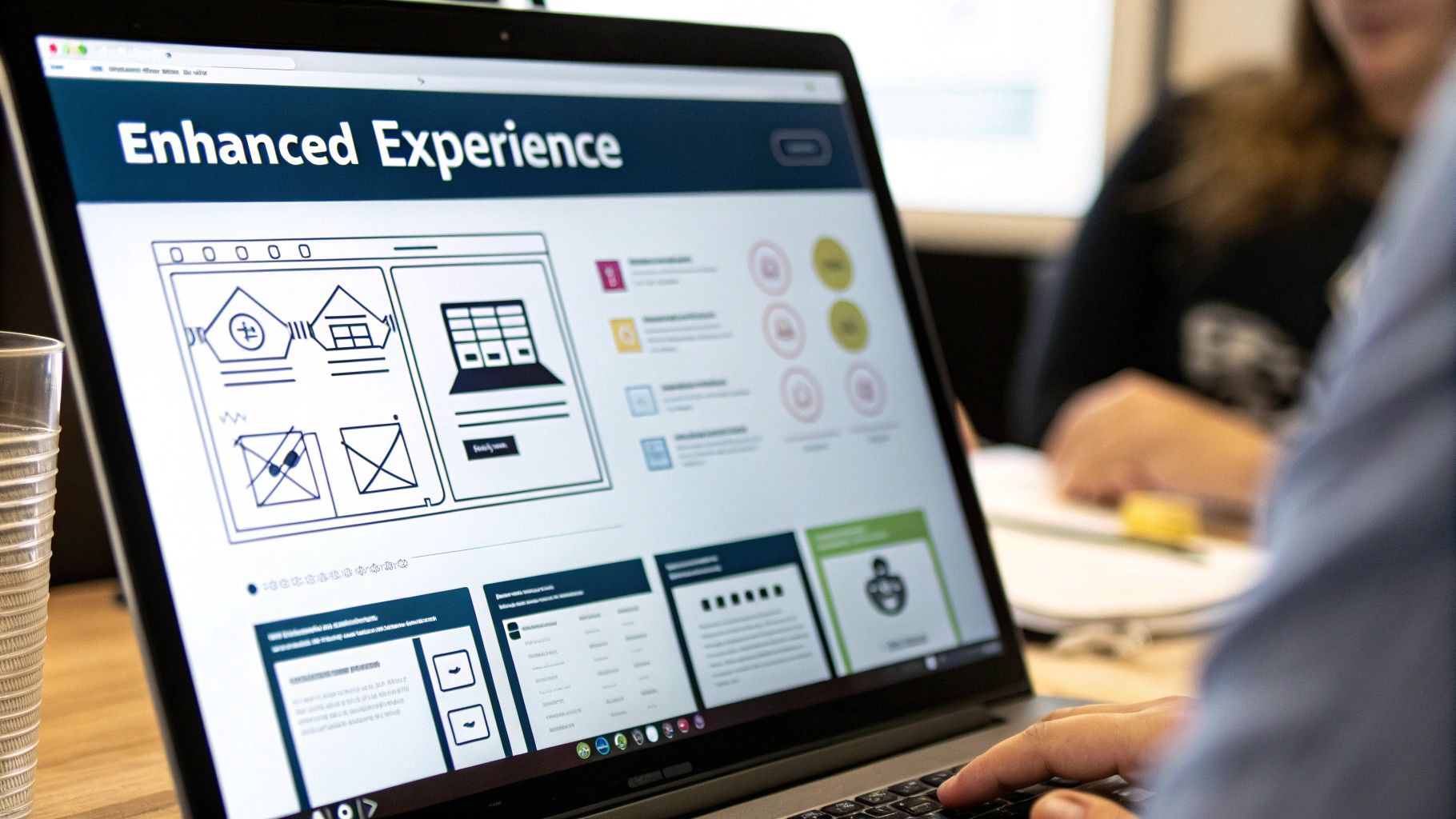Good web design is a make-or-break factor for your business. It's what greets every visitor, shapes their perception of your brand, and ultimately guides them toward becoming a customer. A thoughtful, professional design isn't just a nice-to-have; it's a fundamental investment in your company's growth.
Your Website Is Your Digital Handshake
Think about the last time you met someone for the first time in a professional setting. A firm, confident handshake immediately sets a positive tone, right? Your website does the exact same thing in the digital world. It's your business's first handshake, and it forms an immediate judgment in a visitor's mind—often in the blink of an eye.
This snap judgment happens long before they read a single word of your copy. It’s almost entirely visual. A clean, professional, and intuitive design signals competence and trustworthiness. On the flip side, a cluttered, dated, or confusing website is like a limp, awkward handshake. It creates instant doubt and makes people question if you're a credible business. This is why great web design is so critical; it’s the very foundation of trust.
The Power Of A First Impression
The numbers don't lie. Research consistently shows that a staggering 94% of first impressions are purely design-related. Let that sink in. Nearly every single person who lands on your site decides whether to trust you based on its look and feel.
Even worse, bad design actively drives people away. Studies show 38% of people will simply leave a website if they find the layout unattractive. You can learn more about how design choices directly shape user perception and business outcomes.
That initial impression isn't just about pretty pictures; it’s about sending a clear signal that you are a serious, professional organization that is worth their time.
A great first impression isn't a luxury; it's a gatekeeper. Without it, your most compelling message or valuable product will never get a chance to be seen because the user has already clicked away.
The connection between design improvements and business metrics is undeniable, as the data below illustrates.
As you can see, investing in a better user experience delivers real, tangible returns in engagement and conversions—a trend that only grows stronger as mobile traffic continues to rise.
The Anatomy Of A Strong First Impression
So, what exactly goes into crafting that crucial first impression? It’s not just one thing, but a handful of core design elements working in harmony. Each piece sends a subtle but powerful message to your visitors.
The table below breaks down how some of these key elements influence a user's initial perception.
| How Key Design Elements Shape First Impressions |
| :— | :— |
| Design Element | Impact on User Perception |
| Layout & Composition | An organized, uncluttered layout says you are organized and respect the user's time. It makes information feel accessible and easy to digest. |
| Color Palette | Colors instantly evoke emotion. Professional blues can build trust and a sense of calm, while a vibrant orange can signal energy and fun. |
| Typography | The fonts you choose affect both readability and brand personality. A clean, sans-serif font might feel modern, while a classic serif can suggest stability and tradition. |
| Imagery | High-quality, original photos and graphics show you're professional and authentic. Stock photos can sometimes feel generic and uninspired. |
| White Space | Using negative space effectively prevents a cluttered feel. It creates a sense of sophistication and helps focus the user's attention on what's most important. |
These elements come together to create a powerful, non-verbal introduction to your brand. When you get this digital handshake right, visitors are far more likely to stick around, explore what you have to offer, and begin the journey toward becoming a loyal customer.
Building User Trust Through Thoughtful Design
More than just pretty pictures, great design is fundamentally about building a solid foundation of trust with your visitors. Think of it like a physical storefront. If you walk into a shop that’s clean, bright, and well-organized, you instantly feel at ease and confident you'll find what you're looking for. A cluttered, messy store? It just creates doubt and frustration.
Your website operates on the exact same principle. A thoughtful user experience (UX) design creates a seamless, intuitive journey that quietly builds confidence with every click. When people can easily find information and navigate without friction, they see your business as professional and reliable. This is precisely why the design of a website is important—it’s a direct reflection of your company's competence.
Take Apple.com, for instance. Its generous use of white space and a crystal-clear visual hierarchy guides you effortlessly. This minimalist approach removes all the noise, making the experience feel intuitive and trustworthy. It perfectly reinforces the brand's reputation for precision and quality.
The Pillars of a Trustworthy Design
This kind of digital trust doesn’t happen by accident; it rests on a few key design pillars. A clunky interface or confusing navigation doesn't just annoy people—it actively chips away at their confidence in your brand. A design that feels amateurish makes them wonder if your products or services are just as sloppy.
To steer clear of that pitfall, you need to focus on creating a dependable experience:
- Logical Navigation: Menus and site structure should be so predictable that users don't even have to think about where to go next. Finding what they need should take just a few clicks.
- Clear Information Architecture: Organize your content logically. Use clear headings and scannable text to help people digest information quickly and without effort.
- An Error-Free Interface: Broken links, slow-loading images, and buggy features send a clear message: you don't care about the details or the user's time.
A polished design is a promise. It tells your visitors you’re a credible and professional organization they can count on.
Security as a Core Design Element
Trust isn't just about smooth sailing through your site; it's also about feeling safe. That little padlock icon in the browser bar, which comes from an SSL certificate, is no longer a "nice-to-have." It’s a non-negotiable design feature that signals the connection is secure and any data shared is protected.
The data backs this up in a big way.
Studies reveal that a staggering 38% of users will leave a website if the layout is unattractive. Even more critically, 68% will abandon sites that lack obvious security features like an SSL certificate.
This shows that trust is a combination of both visual polish and tangible safety measures. To make sure your site is fostering this deep level of trust, it’s worth digging into the best practices for user interface design, which expertly blend aesthetics with function.
Ultimately, a trustworthy design makes people feel safe enough to stick around, share information, or even make a purchase.
How Great Design Supercharges Your SEO
It's a common mistake to think of web design and Search Engine Optimization (SEO) as two completely separate jobs. The truth is, they're more like two sides of the same coin. A great design is actually the bedrock of a strong SEO strategy because search engines like Google don't just read your code—they pay close attention to how real people behave on your site.
Think of a search engine bot like a librarian trying to figure out where to shelve a new book. If the book (your website) has a clear table of contents, organized chapters, and all its pages intact, it’s a breeze to categorize. This is where the technical side of design comes into play. Clean code, a logical site structure, and fast loading times are what make it easy for search engines to crawl and understand your content.
But that’s just one piece of the puzzle. The other, arguably more important, piece is all about user signals.
Why User Signals Matter to Google
User signals are simply the behaviors that tell Google whether people are actually having a good time on your site. When visitors are happy, they send positive signals that can directly improve your search rankings.
A well-designed website that is easy to navigate and visually appealing keeps visitors engaged and encourages longer visits. Lower bounce rates and higher engagement signal to search engines that the site is valuable and relevant, further boosting its SEO performance.
Great design has a direct impact on these critical metrics:
- Time on Page: When a design is engaging and easy to read, people stick around longer to soak up your content.
- Bounce Rate: If a site is slow, confusing, or just plain ugly, visitors will hit the back button almost instantly. A high bounce rate is a red flag to Google that your site isn't what users were looking for.
- Pages per Session: Smart, intuitive navigation and clear calls-to-action nudge people to explore more of your site, signaling deep interest and engagement.
Turning Design into SEO Wins
At the end of the day, a fantastic user experience is one of the most powerful SEO tools you have. Google's entire mission is to give its users the best, most relevant results for what they're searching for. When your design creates an outstanding experience, you're essentially aligning your website with Google's main goal.
This sends a powerful message that your site is a high-quality resource that deserves a top spot.
Every single design choice matters, from the overall architecture of your site to the way you structure your headings. To make sure your fantastic design is also firing on all SEO cylinders, it’s a good idea to follow a comprehensive on-page SEO checklist. This helps you perfectly blend a great user experience with the technical details search engines are looking for.
Why Mobile-First Design Is a Business Imperative
In our world, the internet lives in our pockets. Most people reach for their phone to search, shop, and connect, which means designing for that small screen is no longer a "nice-to-have"—it's an absolute must. If your website isn't built for mobile, it's like locking the front door to your store while telling everyone you're open for business.
The urgency comes down to one massive change from Google: mobile-first indexing. Think of it like this: when Google's bots crawl the web to decide how to rank pages, they now look at your mobile site first. That version is the official one in their eyes, not your desktop site.
This single shift makes it crystal clear why web design is so critical. A clunky, slow, or hard-to-navigate mobile site will actively hurt your search rankings, pushing you down the results and making it much harder for new customers to find you.
The User’s Perspective on Mobile
Let's step away from the technical side for a moment and think about the human experience. Have you ever landed on a website on your phone, only to be met with a shrunken-down version of their desktop site? You’re forced to pinch, zoom, and struggle to tap the right link. It’s an incredibly frustrating game that usually ends with a quick tap of the back button.
This isn’t just a minor annoyance; it’s a business killer. A bad mobile experience sends a clear message: this company doesn't care about my needs. It erodes trust before you even have a chance to make your pitch. A smooth, intuitive mobile design, on the other hand, creates an instant sense of professionalism and care.
The Business Impact of Responsive Design
The solution is a responsive design—a design that fluidly adjusts to fit any screen, from the smallest phone to the largest desktop monitor. This isn't just about looking good; it's about driving real business results. The data tells a compelling story about how a mobile-friendly site becomes a profit-generating machine.
The global shift to mobile-first is undeniable. Since Google's indexing change in 2018, having a responsive design has become essential for SEO. Statistics show that 74% of users are less likely to return to a site if it isn't mobile-friendly, directly impacting visitor retention and potential revenue.
It gets even better. Responsive sites can get up to 50% more traffic and see a 20% boost in conversion rates compared to non-responsive ones. This isn't just a small tweak; it's a huge opportunity, as you can see in these web design trends and statistics.
At the end of the day, investing in a flawless mobile experience is one of the smartest business moves you can make. It strengthens your SEO, makes users happy, and directly contributes to your bottom line by converting frustrated visitors into loyal customers.
Turning Visitors Into Customers with Strategic Design
A beautiful website is nice, but a strategically designed one is what actually builds a business. At the end of the day, your website's main job is to turn casual browsers into paying customers. Every single design choice, from the color of a button to the layout of a form, plays a part in that journey. We call this process conversion.
But a conversion isn't always a direct sale. It's any meaningful action you want a visitor to take—signing up for your newsletter, filling out a contact form, or downloading a guide. Strategic design is all about gently leading people toward that goal, making the path so intuitive that taking action feels like the obvious next step.
Guiding the User Journey with Design
Think of your website as a physical path through a store. A smart design uses visual cues to lead visitors exactly where you want them to go, removing any roadblocks and building momentum toward the checkout counter. This is where the psychology of design becomes one of the most powerful tools in your arsenal.
Here are a few key design elements that get people to act:
- Visual Hierarchy: This is simply about telling the user's eye where to look first. Using size, color, and placement, you can immediately spotlight your most important message and your call-to-action.
- Color Psychology: Colors do more than just make things look pretty; they trigger emotions and encourage action. A brightly colored "Buy Now" button on a neutral background is hard to ignore.
- Frictionless Processes: Nothing kills a conversion faster than a confusing checkout process or a ridiculously long form. By simplifying these steps and only asking for what's truly essential, you remove the barriers that make people give up.
Ultimately, the effectiveness of your web design is measured by its ability to turn visitors into customers, and employing strategies to improve website conversions is key to achieving this.
For instance, A/B testing—where you compare two versions of a page to see which one performs better—often shows that tiny design changes can produce huge results. I've seen clients double their clicks just by changing a button's color from gray to green or moving it to a more visible spot on the page.
This is where you see a clear return on investment. Good design isn't just an expense; it’s a direct revenue driver. For businesses ready to see how this works in practice, exploring options for affordable small business website design is a fantastic first step toward building a site that not only looks great but actively grows your bottom line.
Outpacing Your Competition
Let’s be honest—your website doesn’t live in a bubble. It's constantly being compared, consciously or not, to your competitors' sites. In a crowded marketplace, your web design is one of the most powerful tools you have to stay a step ahead.
Think of it this way: a sharp, modern website instantly tells visitors your business is current, active, and a serious player. On the flip side, a site that looks like it hasn't been touched since 2010 can make your entire operation seem out of touch, practically gift-wrapping customers for your competition.
Your rivals' websites set the benchmark for what users expect. If their site is easier to navigate, loads in a flash, or just feels more professional, they've just defined the standard. Falling short of that standard isn't just a design problem; it's a business problem that can cost you real market share. People naturally drift toward the path of least resistance, and that’s always the brand offering the smoothest online experience.
Setting Your Brand Apart
To truly stand out, your design has to be more than just pretty—it needs to be strategic. It's about making a deliberate choice to position your brand as a forward-thinking authority. This doesn't mean you have to jump on every fleeting design trend, but it does mean embracing modern principles and technologies that genuinely make your user's life easier.
Keeping your design fresh and effective helps you:
- Project Authority: A professional, well-thought-out design builds instant credibility. It shows you take your business seriously, so your customers should too.
- Grab Attention: In a sea of cookie-cutter templates, unique and memorable design choices can make your brand the one people remember.
- Keep Customers Around: A fantastic user experience creates loyalty. When your site just works, customers have little reason to see what else is out there.
A strong competitive position isn't just built on better products or lower prices. It's built on perception, and your website is the engine driving that perception online.
Ultimately, this all comes back to a cohesive strategy. Understanding the deep connection between website design and digital marketing ensures that every font, color, and layout choice actively supports your bigger goals. Investing in your website is a direct investment in your future standing in the market.
Still Have Questions About Web Design's Impact?
Even after seeing all the evidence, it's completely normal for business owners to pause and ask a few more questions before investing in professional design. Let's tackle some of the big ones I hear all the time.
Think of this as clearing up any lingering doubts so you can feel confident about how a great website fits into your bigger business picture.
How Quickly Can I Actually See Results?
Almost instantly. I'm not exaggerating.
The first impression of your website is formed in just 50 milliseconds. That's a literal blink of an eye. In that split second, a visitor has already made a snap judgment about your credibility. A sharp, professional design immediately signals that you're trustworthy. A clunky, outdated one? It can send them clicking away before they've even had a chance to read a single word.
This gut reaction has a direct effect on critical metrics:
- Bounce Rate: When a site is inviting and easy to navigate, people stick around to explore.
- User Trust: Polished visuals and intuitive layouts tell visitors you’re a serious, reliable business.
After a redesign goes live, it's common to see positive shifts in user engagement and bounce rates within just a few days.
Is Great Design Really Worth the Money?
Yes, without a doubt. But you have to stop thinking of it as an expense. It's an investment, and one with a fantastic return.
Strategic design isn't just about making things look pretty; it's about actively guiding users to take the actions you want them to take, like buying a product or scheduling a call.
A great website isn't an expense line on a budget. It's a strategic asset that builds trust, enhances user experience, and drives conversions, delivering a return on investment that grows over time.
Even small, thoughtful changes—like moving a button to a more intuitive spot or simplifying a confusing checkout form—can have a massive impact on your revenue. A well-designed website pays for itself many times over by converting casual visitors into paying customers. It’s one of the smartest investments you can make for your company's long-term health.



